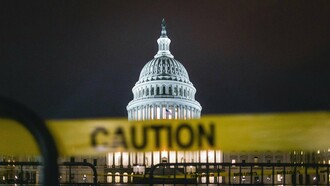A shoe hurled at the Chief Justice of India by a lawyer on a Monday morning has left a nation stunned. However, the despicable act of desecration of the country’s highest judicial officer was more of a subtext of the wretched caste system that divides people based on their birth.
Chief Justice BR Gavai handled the situation very calmly, and admirably so, when lawyer Rakesh Kishore, 71, flung a shoe at him while shouting, “We will not tolerate insults to Sanatan Dharma” in Hindi.
Sanatan Dharma is the ancient religion, the precursor to Hinduism as it is known today, based on Vedic texts and laws that permit categorization of people into thousands of castes based on their birth. With Hindu nationalism at its peak, the puritanical Sanatan Dharma is back in vogue in all its rigidity.
The chief justice, however, stayed calm and told the packed and shocked courtroom, “Don't get distracted by all this. We are not distracted. These things do not affect me.”
The bar council immediately revoked Kishore’s membership in the bar council. But by then, the lawyer had become an overnight hero of the Hindu right-wing ecosystem, media, and social media handles.
The lawyer said he was “offended” at Gavai’s remarks days earlier while dismissing a Public Interest Litigation seeking judicial direction to restore a beheaded statue of the Hindu god Lord Vishnu at the Unesco heritage site of Khajuraho Temple in Madhya Pradesh, central India.
While dismissing the plea, the chief justice had remarked that it was “purely a Publicity Interest Litigation” and light-heartedly asked the petitioner to “go and ask the deity himself.” But the observation attracted severe criticism from the Hindu right wing, including a whole host of right-wing television channels.
Prime Minister Narendra Modi condemned the shoe attack eight hours later in a post on X, stating that the incident had “angered every Indian.”
While the chief justice didn’t press charges, the police didn’t book the offending lawyer. A case was, however, filed in Bengaluru, the southern metropolis, based on a complaint lodged by a lawyers’ body. It has since been transferred to the Delhi Police, which, on its own, didn’t book a case against Kishore.
But the shoe-hurling act has more to it than meets the eye.
What is caste?
One of the most unique characteristics of the Hindu religion is its caste system, which mandates people living according to the caste they are born into, with no room for any alteration. Ancient Hindu texts refer to “chaturvarnya”, or four different levels of hierarchically placed caste groups.
According to the much-abhorred caste system, the Brahmins lay on top of the heap, thus enjoying all the privileges of being the priestly class. They are followed by Kshatriyas (warriors), Vysyas (trading communities), and Shudras (the lowest social group).
But that’s not all. These four are followed by a large number of “Untouchables” bracketed as Scheduled Castes and Scheduled Tribes, also known as Dalits and Adivasis, respectively.
To its credit, India’s ruling Hindu-nationalist Bharatiya Janata Party (BJP) has a member of the backward classes as the prime minister. At the same time, it elected two successive Indian presidents from the oppressed communities. While President Draupadi Murmu is a member of the Scheduled Tribes, or Adivasi (indigenous people) community, her predecessor Ramnath Kovind is from the Scheduled Castes, or a Dalit (broken in the Marathi language).
Kovind is only India’s second Dalit president after KR Narayanan, who was elected in 1997 by the then Janata Dal (United) government, supported by the Congress. But, while the prime minister is the most powerful political figure under India’s parliamentary democracy, the president is a ceremonial figure.
Narayanan, Modi, Kovind, and Murmu rose from humble beginnings, mainly due to their caste status, to occupy the top offices.
Gavai is only the second Dalit and first Buddhist to head the Supreme Court of India in a hugely Hindu-majority country.
He was on the bench that delivered a landmark judgment against what has come to be known as “bulldozer justice”. This pertains to several acts of arbitrary demolition of private properties, including homes, of mostly Muslims accused of crimes in the guise of removing illegal structures.
While such bulldozer justice has no place in Indian law, several such “punitive” actions have been reported from BJP-ruled Uttar Pradesh, also a North Indian state.
But although millions of the so-called Untouchables have, over the decades, converted to Islam, Christianity, Buddhism, and Sikhism (the Sikh faith), most of them have not been able to escape the social stigma attached to their caste, or by their birth, to be more precise.
Dalits who embraced other faiths to escape the dreaded casteism thus became ‘Dalit’ Christians and ‘Dalit’ Muslims, unable to shake off the very identity they wanted to get rid of.
How caste works
Another incident that happened during the same week as the shoe-hurling episode further emphasizes the social and mental impact of caste and its various subtexts that refuse to go away, irrespective of what one achieves in education and professional life.
A 52-year-old Indian Police Service (a national-level elite service) officer, Y. Puran Kumar, was found dead in his room with a gunshot wound to his head, indicating suicide.
In an eight-page suicide note, Kumar had blamed nine serving IPS officers of the Haryana state police, also in the north of India; a retired IPS officer; and three retired Indian Administrative Service (an elite civil service) officers over “caste-based discrimination”.
Kumar was a Dalit, or ‘Untouchable', who rose through the police ranks after qualifying for the highly competitive national civil service exams that accorded him the IPS status. Yet he could not ward off the caste stigma that he lived with and was allegedly discriminated against by his upper-caste superiors.
As I wrote this article, the Indian media reported how a man from a backward caste in Madhya Pradesh was made to wash a Brahmin man’s feet. His only fault was sharing an AI-generated image depicting the Brahmin man with a garland made of shoes for allegedly violating the village’s collective decision to ban alcohol.
In a video that circulated on social media platforms, the victim, identified as Purushottam Kushwaha, can be heard saying: “I apologize to the Brahmin community. Such a mistake will not be repeated. We (ostensibly the backward classes like him) will keep worshipping Brahmins like this.
In another video that went viral on social media, two women caught for ticketless traveling in a first-class coach of a train can be heard using caste slurs against the ticket checker, who is apparently from one of the oppressed castes.
Not a day passes in India without such incidents. But only a few of them get reported, and least of all, charged or convicted.
Ambedkarite
Like the chief justice, the dead police officer too was a follower of Dr BR Ambedkar, an eminent scholar and jurist who is the chief architect of the Constitution of India.
A prolific writer and orator, Ambedkar’s life itself is an inspiration for many of the so-called Untouchables. Born in 1891 into a Dalit family in today’s state of Maharashtra in western India, Ambedkar was among the most radical thinkers who fought for the rights of millions of oppressed people.
Being a Dalit child, Ambedkar even had to sit in a far corner of the classroom and bring his own rug to sit on, and was not allowed to drink water from the container meant for other students. Being the excellent student he was, and financially aided by his poor family and later a Hindu ruler, he did his bachelor’s in Bombay (now Mumbai), master’s and PhD at Columbia University, US, a doctorate from the London School of Economics, and Barrister-at-Law in London, among others.
He was among the few Dalits who scaled great heights. Yet, even Ambedkar was not spared caste slurs. Fed up with trying to reform the Hindu faith, Ambedkar embraced Buddhism before he died in 1956.
A majority of the Dalits and backward classes are still caught in the system, although affirmative action has helped large numbers to get educated and escape economic misery, albeit burdened with the caste stigma.
According to a 2021 Pew Research Center study, 68 per cent of Indians identify themselves as members of the lower castes. While 25 per cent identify as Scheduled Castes and 9 per cent as Scheduled Tribes, 35 per cent of Indians are from the backward classes. Yet, they have very little representation in the top bureaucracy, judiciary, corporate boardrooms, and even the media.
Although much has changed in the Hindu society through social reforms and affirmative action that ensure a certain number of jobs and educational opportunities for the ‘Untouchables’, much more needs to be done, as reflected by the recent incidents.
Both the chief justice and the police officer identify themselves as ‘Ambedkarites’, signifying themselves as followers or students of the works of one of the tallest figures in modern Indian history.
His speech, which was not delivered but published as a book, Annihilation of Caste, is arguably the most powerful literature that efficiently establishes why annihilating the caste system is the only way out of the debased social hierarchy.
Booker Prize-winning author and renowned socio-political commentator Arundhati Roy wrote a book titled The Doctor and The Saint in 2017 about the clash of ideology between Ambedkar and Mahatma Gandhi, and why Annihilation of Caste fills a gaping hole in what is taught in schools.
“When I first read it, I felt as though somebody had walked into a dim room and opened the windows. Reading Dr Bhimrao Raoji Ambedkar bridges the gap between what most Indians are schooled to believe in and the reality we experience every day of our lives,” Roy writes.
An apartheid of sorts, caste discrimination is still prevalent in India. Even the more educated and economically developed South India is not entirely free from it.
In certain villages in the southern state of Tamil Nadu, certain ‘Untouchables’ have to remove their footwear and step off their bicycle or motor vehicle while passing upper-caste villages.
Caste hides in various forms and shapes even in Kerala, for long considered the most progressive state. Governed today by a forward-looking political coalition helmed by the Communists, caste still calls the shots in several aspects of daily life.
The Communist government dared to break the Brahmin monopoly in temple priests by appointing members of the backward castes and Dalits. But strong resistance and defiance by the traditional Brahmin priests proved an insurmountable barricade in major temples. This has limited the so-called lower-caste appointees to either smaller temples or insignificant tasks in larger temples.
While progressive movements in the southern states had encouraged people to drop caste names, which they usually use for surnames, and adopt either family names or merely initials, things are moving backward now.
Even educated youngsters from outwardly progressive families aggressively flaunt their caste names, many of them even on the car windscreens as a sign of dominance or even defiance.
A cursory glance at the matrimonial advertisements in newspapers, even in the more progressive South India, would reveal how young men and women seek partners from their own castes.
More often, as in the shoe-hurling incident or the police officer’s death, it’s not that one or two incidents would leave a direct impact on the battle against caste discrimination. But these incidents leave a chilling effect that will last longer than one can imagine.















